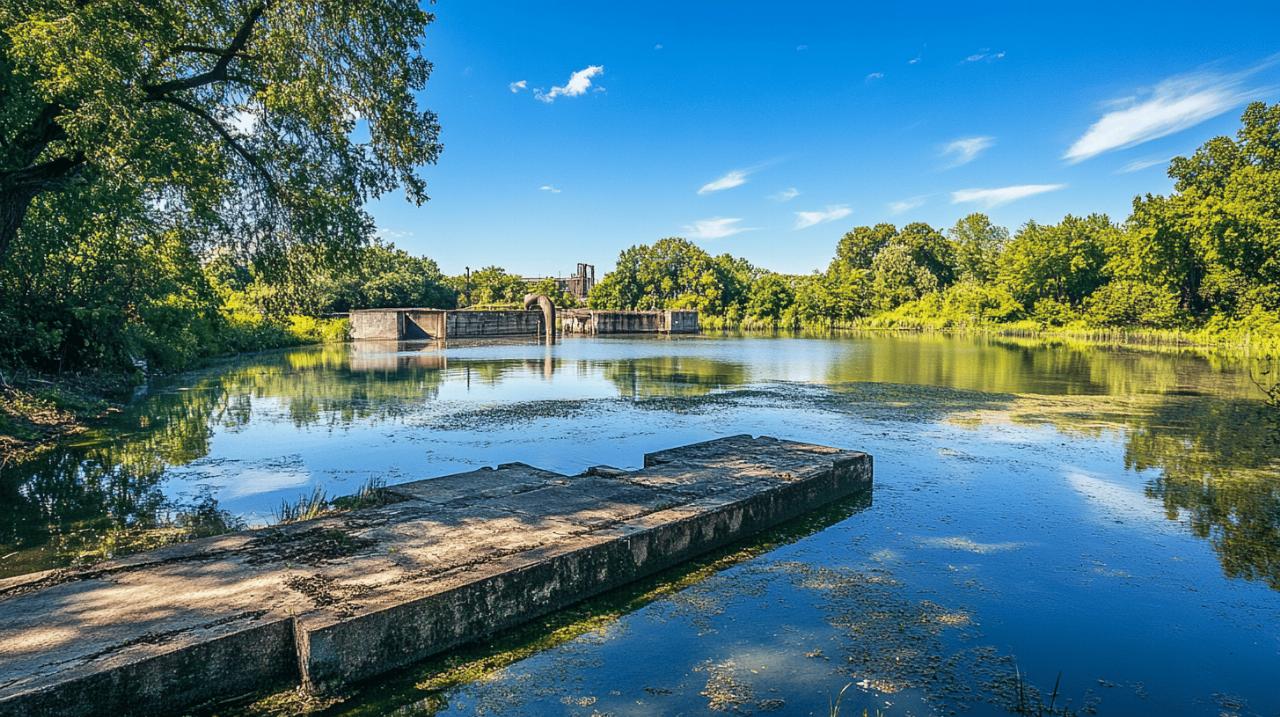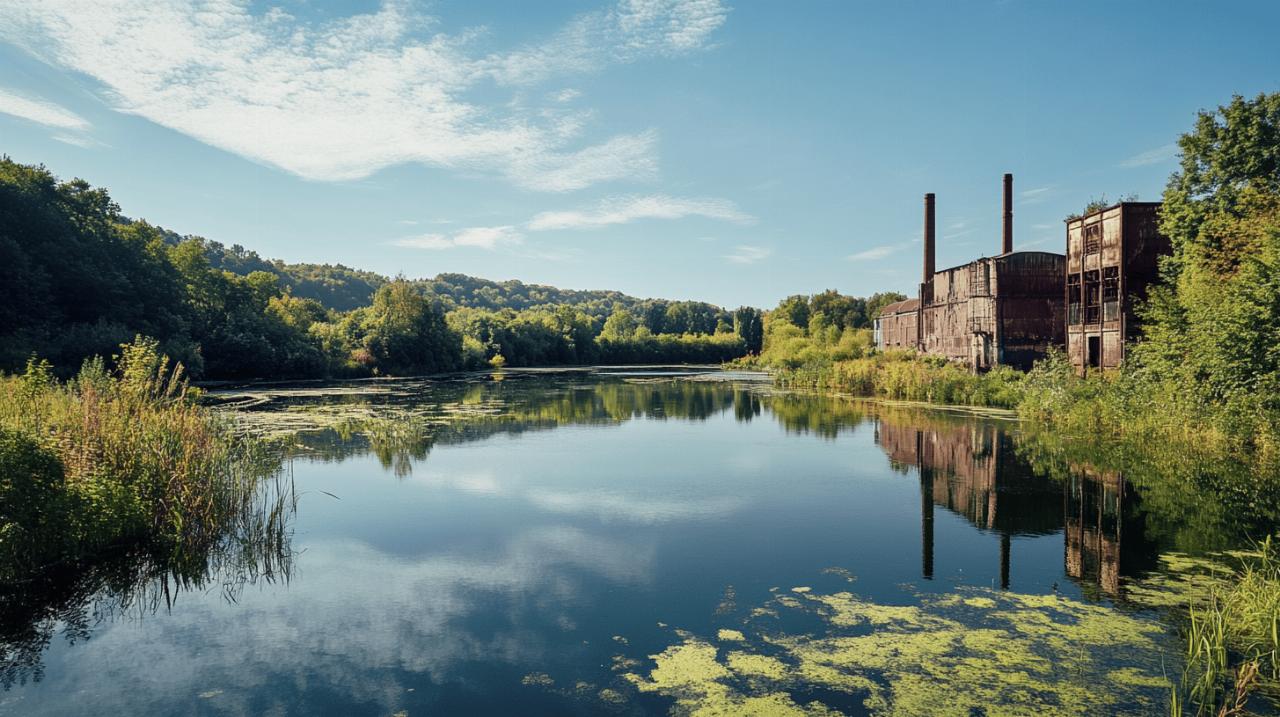The Environmental Legacy of Lac des Ciments: Identifying Key Pollution Sources in Val-d’Oise
The story of Lac des Ciments is one of transformation and legacy, where industrial ambition has left behind a striking yet troubled water body. Nestled in the Val-d'Oise department near Beaumont-sur-Oise, this lake draws visitors with its clear waters and unique island, yet beneath the surface lies a complex environmental narrative. Once a thriving chalk quarry, the site now serves as a public space for recreation, albeit under strict restrictions that reflect the lingering hazards of its industrial past. Understanding the pollution sources at Lac des Ciments requires delving into both its historical operations and the contemporary pressures it faces, revealing a delicate balance between human activity and environmental stewardship.
From Chalk Quarry to Recreational Lake: The Industrial Origins of Lac des Ciments
Historical quarrying operations and their environmental footprint
The genesis of Lac des Ciments lies in the extensive quarrying operations that once dominated the landscape near Beaumont-sur-Oise. For decades, chalk extraction was a cornerstone of local industry, supplying materials for cement production and other construction needs. The quarrying process involved removing vast quantities of chalk, which gradually carved out a deep basin in the earth. This industrial activity, while economically beneficial, left an indelible mark on the environment. The excavation created a water-filled cavity that would eventually become the lake known today. The machinery, chemical agents, and waste materials associated with cement manufacturing introduced a range of pollutants into the surrounding soil and water. Heavy metals, alkaline compounds, and particulate matter from the quarrying and processing activities settled into the basin, forming a layer of contamination that persists to this day. The depth of the lake, which reaches considerable measurements in metres, is a direct consequence of the intensive extraction efforts, and this depth now poses both recreational and environmental challenges.
The transformation process: when industry leaves behind a water body
When quarrying operations ceased, nature began to reclaim the site. Rainwater and groundwater gradually filled the excavated basin, creating what appeared to be a serene lake. However, this transformation was not merely a return to a pristine state. The water that accumulated in the quarry pit interacted with the residual materials left behind, including cement dust, lime deposits, and other industrial by-products. This chemical interaction altered the water quality, creating a unique but hazardous aquatic environment. The lake's proximity to nearby communes such as Ysieux, Mours, and Nointel meant that its evolution into a public space was almost inevitable, despite the underlying risks. The site attracted attention for its visual appeal and potential for water sports, yet the legacy of its industrial origins remained embedded in the very fabric of the lake. The transformation from a productive quarry to a recreational area was incomplete, as the environmental footprint of the past continued to shape the present.
Understanding the Pollution Profile: Primary Contaminant Sources at Lac des Ciments
Legacy Industrial Pollutants from Cement and Chalk Extraction
The primary pollution sources at Lac des Ciments are inextricably linked to its history as a chalk quarry and cement production site. The extraction and processing of chalk involved the use of various chemicals and machinery that contributed to long-term contamination. Alkaline compounds, particularly calcium hydroxide and calcium oxide, were byproducts of the cement-making process and these substances have leached into the lake water over time. Such compounds can significantly alter the pH balance, making the water more alkaline than natural freshwater bodies. Additionally, heavy metals such as lead, cadmium, and chromium, often associated with industrial machinery and waste, have been detected in sediments at the lake bed. These metals pose a serious risk to aquatic life and can accumulate in the food chain, potentially affecting any organisms that inhabit or come into contact with the water. The depth of the lake exacerbates the problem, as pollutants settle at the bottom and remain largely undisturbed, creating a reservoir of contamination that is difficult to remediate. The legacy of cement production has left a chemical signature that continues to define the environmental profile of the lake.
Contemporary pollution pressures: recreational use and urban runoff
While the historical industrial activities are the primary source of pollution, contemporary pressures have also contributed to the degradation of water quality at Lac des Ciments. Despite the ban on swimming, the lake remains a popular spot for various water sports and recreational activities, including diving. The presence of groups such as the French Federation of Speleology and Marine Studies, known as FFESSM, indicates that the site is used for organised underwater activities. Human activity, even when regulated, introduces pollutants such as oils, fuels, and personal care products into the water. Moreover, the lake's location near urban areas means it is subject to runoff from surrounding roads and developments. Stormwater carries with it a cocktail of contaminants, including automotive fluids, pesticides, and litter, which eventually find their way into the lake. The combination of legacy industrial pollutants and modern urban runoff creates a complex pollution profile that poses ongoing challenges for environmental management. The island within the lake, while a picturesque feature, also complicates efforts to monitor and control contamination, as it creates additional zones where pollutants can accumulate.
Safety concerns and environmental hazards: why swimming remains prohibited
Water Quality Analysis: Chemical and Physical Hazards in the Lake
 The prohibition on swimming at Lac des Ciments, enforced by order of the Prefect, is rooted in a comprehensive understanding of the lake's hazardous conditions. Water quality analyses have consistently revealed elevated levels of alkaline substances and heavy metals, making the lake unsuitable for human contact. The pH levels in certain areas of the lake are significantly higher than those found in natural freshwater bodies, posing a risk of skin irritation and chemical burns. Furthermore, the presence of heavy metals in the water and sediment represents a serious health hazard, particularly for individuals with prolonged exposure. The depth of the lake, often described in terms of metres, adds a physical dimension to the danger. Cold water temperatures at depth can lead to rapid hypothermia, and the lack of visibility in deeper areas makes rescue operations extremely difficult. The combination of chemical and physical hazards creates an environment that is fundamentally unsafe for swimming, regardless of an individual's experience or skill level. The prohibition is not merely precautionary but a necessary measure to protect public health.
The prohibition on swimming at Lac des Ciments, enforced by order of the Prefect, is rooted in a comprehensive understanding of the lake's hazardous conditions. Water quality analyses have consistently revealed elevated levels of alkaline substances and heavy metals, making the lake unsuitable for human contact. The pH levels in certain areas of the lake are significantly higher than those found in natural freshwater bodies, posing a risk of skin irritation and chemical burns. Furthermore, the presence of heavy metals in the water and sediment represents a serious health hazard, particularly for individuals with prolonged exposure. The depth of the lake, often described in terms of metres, adds a physical dimension to the danger. Cold water temperatures at depth can lead to rapid hypothermia, and the lack of visibility in deeper areas makes rescue operations extremely difficult. The combination of chemical and physical hazards creates an environment that is fundamentally unsafe for swimming, regardless of an individual's experience or skill level. The prohibition is not merely precautionary but a necessary measure to protect public health.
Tragic Incidents and the Ongoing Risk to Public Health
The dangers of Lac des Ciments are not theoretical but have been tragically demonstrated through incidents that have occurred at the site. The drowning of a young man in the past underscored the severe risks associated with the lake, particularly its depth and the challenges of water rescue. This incident, along with others, prompted heightened scrutiny from local authorities and safety advocates. Jean-Michel Aparicio, among others, has been vocal about the need for comprehensive studies to assess the risks and to develop strategies to make the area safer. The tragic loss of life has galvanised efforts to better understand the environmental and safety challenges at Lac des Ciments, but it has also highlighted the difficulties inherent in managing a site with such a complex history. The lake continues to attract visitors, drawn by its beauty and recreational potential, yet the ongoing risk to public health remains a pressing concern. The balance between allowing access for legitimate activities and ensuring safety is a delicate one, and the tragic incidents serve as a stark reminder of the consequences when that balance is not properly maintained.
Future remediation strategies: protecting val-d'oise's water resources
Proposed environmental studies and monitoring programmes
Addressing the pollution and safety challenges at Lac des Ciments requires a multifaceted approach that begins with rigorous environmental studies and ongoing monitoring programmes. There is a growing consensus among environmental scientists and local authorities that a comprehensive assessment of the lake's water quality, sediment composition, and ecological health is essential. Such studies would provide a detailed understanding of the extent of contamination and the specific pollutants present, enabling the development of targeted remediation strategies. Monitoring programmes would track changes in water quality over time, identifying trends and assessing the effectiveness of any interventions. The involvement of organisations such as FFESSM and other stakeholders in data collection and analysis could enhance the scope and accuracy of these programmes. Advanced techniques, including sediment coring and chemical analysis, would help to map the distribution of pollutants and to identify hotspots where remediation efforts should be concentrated. The goal is not only to address the legacy of industrial pollution but also to mitigate the impact of contemporary pressures, creating a safer and more sustainable environment for the future.
Balancing Recreational Access with Environmental Protection in Former Industrial Sites
The challenge of managing Lac des Ciments lies in balancing the desire for recreational access with the imperative to protect the environment and public health. Former industrial sites such as this lake offer unique opportunities for leisure and sport, yet they also carry inherent risks that cannot be ignored. Any strategy for the future must recognise the dual nature of the site, acknowledging both its appeal and its hazards. This might involve designating specific zones for controlled activities, such as diving, while maintaining strict prohibitions on swimming in areas where contamination is most severe. Enhanced signage and public education campaigns could help to inform visitors about the risks and the reasons for restrictions, fostering a culture of respect for the environment and compliance with safety regulations. Long-term remediation efforts, such as sediment removal or chemical neutralisation, could gradually improve water quality, but these interventions require significant investment and sustained commitment. The future of Lac des Ciments depends on a collaborative approach that brings together local authorities, environmental organisations, and the community, ensuring that this unique water body can be enjoyed safely while preserving the integrity of Val-d'Oise's precious water resources.
